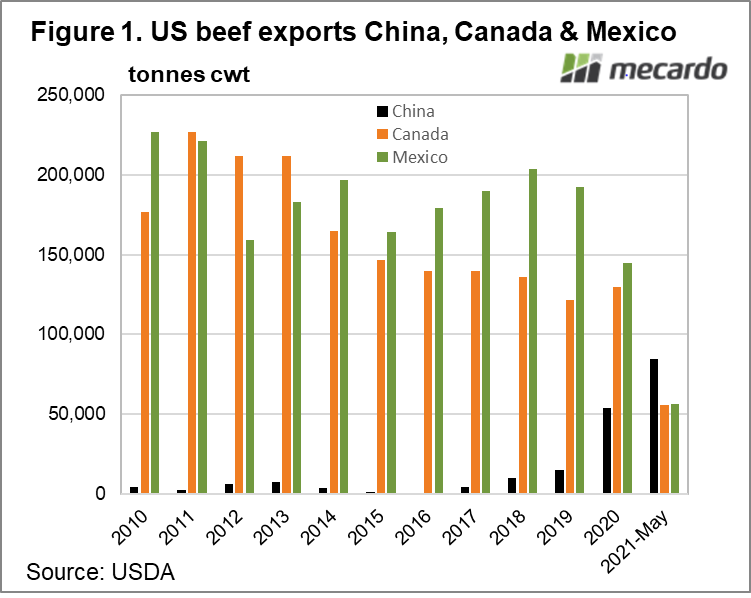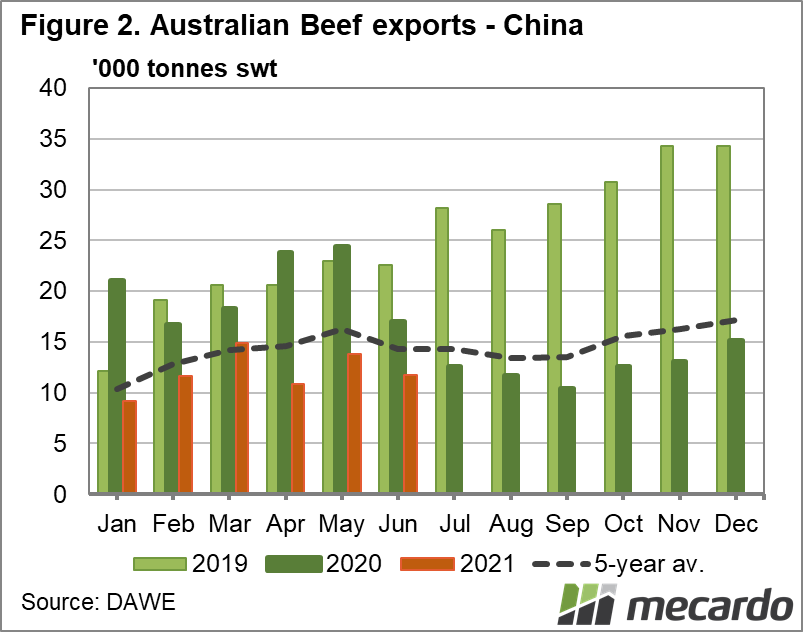The United States is on track to reach new highs in both beef production and beef exports in 2021. Processing levels in the US have recovered from covid disruptions and feedlots are getting back to a more ‘normal’ trading pattern - however cattle numbers on feed for 120 days or more are still well above the five-year average, leaving room for more turnover. According to the United States Department of Agriculture, the US will export 1.5 million metric tons carcase weight equivalent of beef this year, an increase of 8% on the previous record set in 2018.
For the year-to-May, total beef exports out of the US are up 15% in volume, and 22% in value. China is now the third largest beef export market for the US, having overtaken both Canada and Mexico and taking 13% of all US product for the year-to-May. This is compared to just 1.2% in the same period last year. Japan and South Korea remain the two largest US beef markets by far, each receiving close to 25% of all beef leaving the US. US exports to China for May rose 895%, and US beef now accounts for 4% of the Chinese import market, up from 1% in 2019. Most of this market share has been acquired from Australia and Argentina.
The US has been able to pick up market share because of its increased cattle production (compared to Australia’s record low national herd), along with changes to market access created by the US-China Phase-One Agreement. The USDA also reports low pork supplies due to the African Swine Fever still influencing China’s demand for protein. Team this with a lack of supply from Australia (previously the third largest supplier of beef to the Chinese market) and we can see how the US has been able to capitalise. Data to May also doesn’t yet show export restrictions out of Argentina – the second largest beef supplier to China – and those volumes are expected to fall significantly.
Australia’s beef exports to China are 40% lower for the year to date, with monthly volumes trending at about half of the record levels seen in 2019. March was the only month for this calendar year where beef export volumes to China rose above the five-year average, and beef export value to China for the first three months of 2021 (latest data available) was 18% lower year-on-year. While Australia’s market share in China has dipped (by roughly 10%), the share of Australian beef exports purchased by China is down less than 2% year-on-year. This indicates Australia’s constrained supply and subsequent record prices are a key impact.
What does it mean?
At the moment, Australia doesn’t have the supply China needs to fill its protein gap, and the US is picking up the slack. We would be astute to remember that despite China rising to be Australia’s biggest beef market in 2019, Australia’s market share of China’s imported beef has been on the decline for the past five years. So, despite little impact being felt in the short term, with low numbers and good seasons pushing domestic returns to record highs, when Australia’s production returns to pre-drought levels, we could very well need China more than they need us.
Have any questions or comments?
Key Points
- United States beef exports are forecast to reach a record high of 1.5 million metric tonnes this year.
- China is now the United States’ third largest export market, but the US still only makes up 4% of all Chinese beef imports.
- Australian beef exports to China have fallen 40% year-on-year for the calendar year-to-date.
Click to expand
Click to expand
Data sources: USDA, Mecardo



